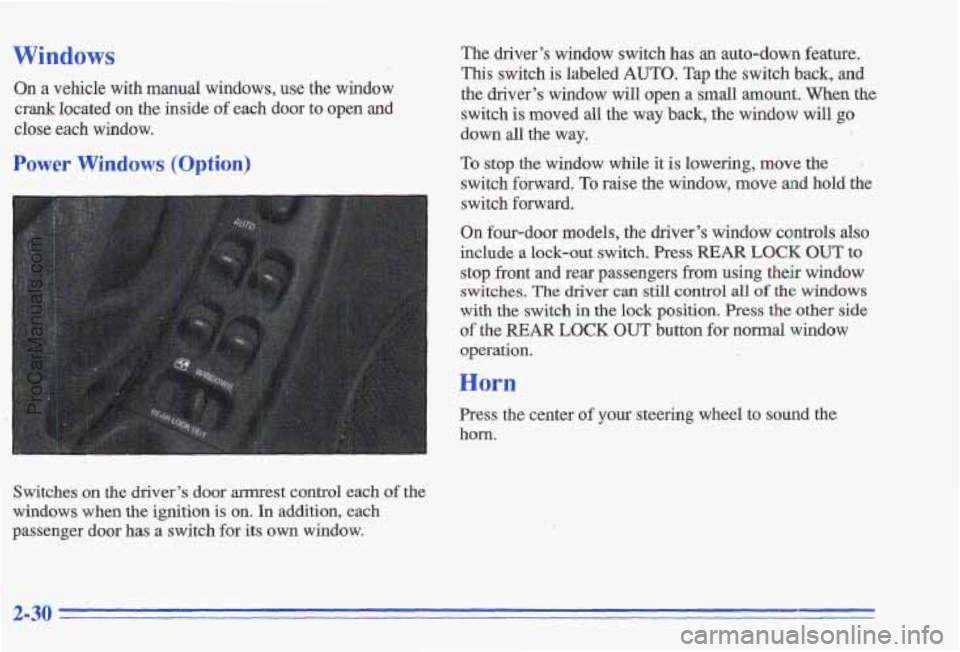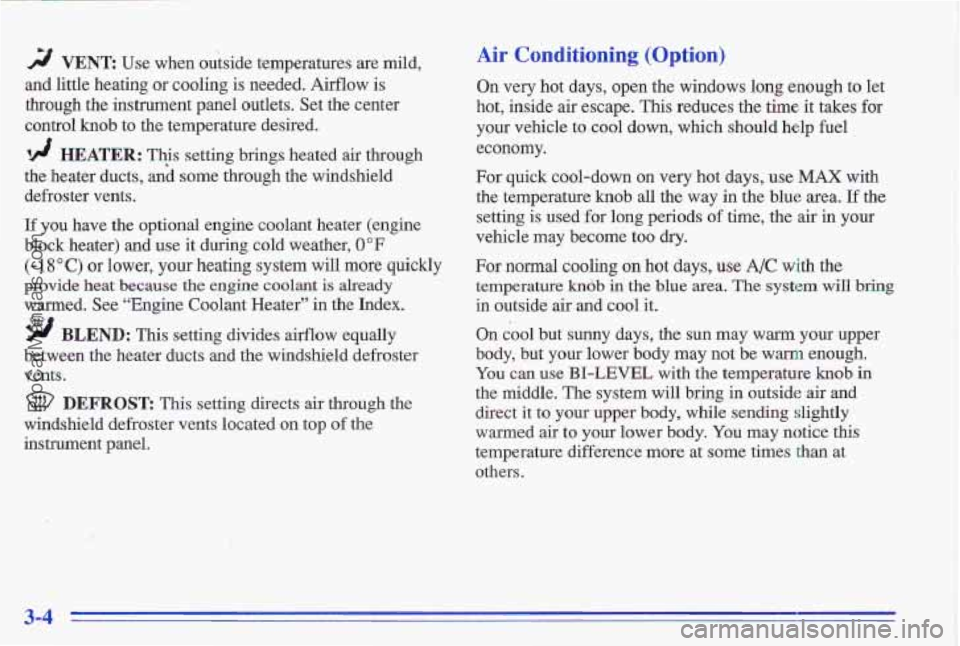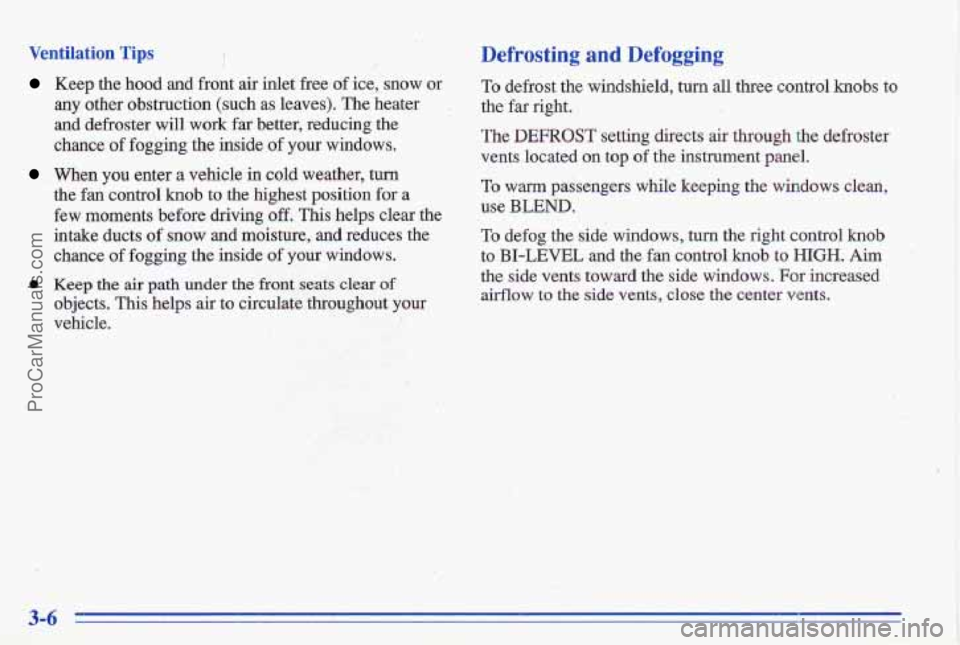Page 86 of 356

Windows
On a vehicle with manual windows, use the window
crank located on the inside of each door to open and
close each window.
Power Windows (Option)
Switches on the driver’s door armrest control each of the
windows when the ignition is on.
In addition, each
passenger door has a switch for its own window. The driver’s window switch has
an auto-down feature.
This switch
is labeled AUTO. Tap the switch back, and
the driver’s window will open a
small amount. When the
switch is moved all the way back, the window will go
down all the way.
To stop the window while it is lowering, move the .
switch forward. To raise the window, move and hold the
switch forward.
On four-door models, the driver’s window controls also
include a lock-out switch.
Press REAR LOCK OUT to
stop front and rear passengers from using their window switches.
The driver can still control all of the windows
with the switch in the lock position. Press the other side
of the
REAR LOCK OUT button for normal window
operation.
--
Horn
Press the center of your steering wheel to sound the
horn.
2-30
ProCarManuals.com
Page 107 of 356
Your instlument panel is designed to let you know at a
glance how your vehicle is running. You’ll know how
fast you’re going,
how much fuel you’re using, and
many other things you’ll need to drive safely and
economically.
The main components of your instrument panel are:
A. Fuse Panel
B. Vent
C. Turn Signal/Multifunction ,Lever
D. SRS - Supplemental Restraint System (Air Bag)
E. Hazard Warning Flashers Switch
E Instrument Cluster
G. Windshield Wipersmasher Stalk
H. Audio System
I. Side Window Defogger Vent
J. Glove Box
K. Climate Control System
L. Gear Shift Lever
M. Ashtray
N. Enhanced Traction System (ETS) Switch (Option)
0. Lighter
P. Ignition Switch
Q. Tilt Steering Wheel Lever (Option)
R. Fog Lamp Switch
S. Instrument Panel Intensity Control/ Interior Lamps
Switch
T. Hood Release Handle
2-51
ProCarManuals.com
Page 126 of 356

rF/ VENT Use when outside temperatures are mild,
and little heating or cooling is needed. Airflow is
through the instrument panel outlets. Set the center
control
knob to the temperature desired.
‘!! HEATER: This setting brings heated air through
the heater ducts, aid some through the windshield
defroster vents.
If you have the optional engine coolant heater (engine
block heater) and use it during cold weather,
0°F
(- 1 8 O C) or lower, your heating system will more quickly
provide heat because
the engine coolant is already
warmed. See “Engine Coolant Heater”
in the Index.
9 BLEND: This setting divides aeflow equally
between the heater ducts and the windshield defroster
vents.
DEFROST This setting directs air through the
windshield defroster vents located on top of the
instrument panel.
Air Conditioning (Option)
On very hot days, open the windows long enough to let
hot, inside air escape. This reduces the time it takes for
your vehicle to cool down, which should help fuel
economy.
For quick cool-down on very hot days,
use MAX with
the temperature
knob all the way in the blue area. If the
setting is used for long periods
of time, the air in your
vehicle may become too dry.
For normal cooling on hot days, use A/C with the
temperature
kndb in the blue area. The system will bring
in outside air and cool it.
On cool but sunny days, the sun may warm your upper
body, but your lower body may not be warm enough.
You can use BI-LEVEL with the temperature knob in
the middle. The system will bring in outside air and
direct it to your upper body, while sending slightly
warmed air
to your lower body. You may notice this
temperature difference more at some times than at
others.
3-4
ProCarManuals.com
Page 127 of 356

Hc-4ing
‘lix---lg the right control knob to HEATER and the
center control
knob clockwise sends some heated air
through the heater ducts toward your feet and some
through the defroster vents.
Veri, 3ys1
Use when outside temperatures are mild, and little
heating or cooling is needed. Turn the right knob to
VENT. Airflow is directed through the instrument panel
outlets. Set the center knob to the temperature desired.
VENT and HEATER are economical positions because Your Pontiac’s flow-through ventilation system supplies
the air conditioner compressor doesn’t run in these two outs\
ide air into the vehicle when it is moving. Outside
settings. This reduces engine load, resulting in improved
air will also enter the vehicle when the heater or the air
fuel economy.
If either setting fails to keep you conditioning fan is running.
comfortable, or causes your windows to fog up, turn
the right control
knob to one of the air conditioning Adjust the direction of
positions, or to DEFROST. airflow by moving the
If
you have the optional engine coolant heater (engine
block heater) and use it during cold weather, 0 OF ,
(- 18 O C) or lower, your heating system will more
quickly provide heat because the engine coolant is
already
warmed. See “Engine Coolant Heater”
the Index. louvered vents.
3-5
ProCarManuals.com
Page 128 of 356

Ventilation Tips I
Keep the hood and front air inlet free of ice, snow or
any other obstruction (such as leaves). The heater
and defroster will work
far better, reducing the
chance
of fogging the inside of your windows.
When you enter a 'vehicle in cold weather, turn
the fan control
knob to the highest position for a
few moments before driving off. This helps clear the
intake ducts
of snow and moisture, and reduces the
chance of
fogging the inside of your windows.
0 Keep the air path under the front ,seats clear of
objects. This helps air to circulate throughout your
vehicle.
Defrosting and Defogging
To defrost the windshield, turn all three control knobs to
the far right.
The
DEFROST setting directs ais through the defroster
vents located
on top of the instrument panel.
To warm passengers while keeping the windows cleari,
use
B'LEND.
To defog the side windows, turn the right control knob
to BI-LEVEL and the fan control knob to HIGH. Aim
the side vents toward the side windows. For increased airflow to
the side vents, close the center vents.
3-6
ProCarManuals.com
Page 129 of 356
Rear Window Defogger (Option)
The rear window defogger
uses a warming grid to remove fog from the rear
window. Press the defogger switch. The indicator light
will glow.
If your vehicle is traveling under 45 mph (70 krn/h), the
rear window defogger will
turn off automatically after
about
10 minutes of use. If your vehicle is traveling over
45 mph (70 km/h), the defogger will operate continuously.
You can tum the defogger off by turning off the ignition or
pressing the switch again.
Do not attach a temporary vehicle license across the
defogger grid
on the rear window.
I NOTICE:
Don’t use a razor blade or anything else sharp on
the inside
of the rear window. If you do, you
could cut
or damage the warming grid, and the
repairs wouldn’t be covered by your warranty.
3-7
ProCarManuals.com
Page 170 of 356

The exit speed is usually posted.
Reduce your speed according
to your speedometer, not
to your sense of motion. After
driving for any distance
at higher speeds, you may tend to think you are going
slower than you actually are.
Before Leaving on a Long Trip
Make sure you’re ready. Try to be well rested. If you
must
start when you’re not fresh -- such as after a day’s
work
-- don’t plan to make too many miles that first part
of the journey. Weax comfortable clothing and shoes you
can easily drive in.
Is your vehicle ready for a long trip? If you keep it
serviced and maintained, it’s ready to
go. If it needs
service, have it done before
starting out. Of course,
you’ll find experienced and
able service experts in
Pontiac dealerships all across North America. They’ll be
ready and willing to help
if you. need it. Here are some things
you can check before a trip:
WindshieZd Washer Fluid: Is the reservoir
full? Are
all windows clean inside and outside?
Wiper Blades: Are they in good shape?
Fuel, Engine Oil, Other Fluids: Have you checked
Lamps: Are they all working? Are the lenses clean?
‘Tires: They are vitally important to a safe,
all levels?
trouble-free
trip. Is the tread good enough for
long-distance driving? Are the tires all inflated
to the
‘ recommended pressure?
Weather Forecasts: What’s the weather outlook
along your route? Should you delay your trip a short
time to avoid a major
storm system?
Maps: Do you have up-to-date maps?
4-22
ProCarManuals.com
Page 176 of 356
Tie a red cloth to your vehicle to alert police that
you’ve been stopped by the snow.
Put on extra clothing or wrap a blanket around you.
If you have no blankets or extra clothing, make body
insulators
frob newspapers, burlap bags, rags, floor
mats -- anything you can wrap around yourself or
tuck under your clothing to keep warm. ..
Snow can trap exhaust gases under your vehicle.
This
can cause deadly CO (carbon monoxide) gas
to get inside. CO could overcome you and kill
you. You can’t see it or smell it, so you might not
know it is in your vehicle. Clear away snow from
around the base of your vehicle, especially any
that
is blocking your exhaust pipe. And check
around again from time to time to be sure snow
doesn’t collect there.
Open
a window just a little on the side of the
vehicle that’s away from the wind. This will help
keep
CO out.
You can sun the engine to keen warm, but be careful.
1. ..
‘4 . ’% . , ! 1- . ,;
4-28
.. .
ProCarManuals.com